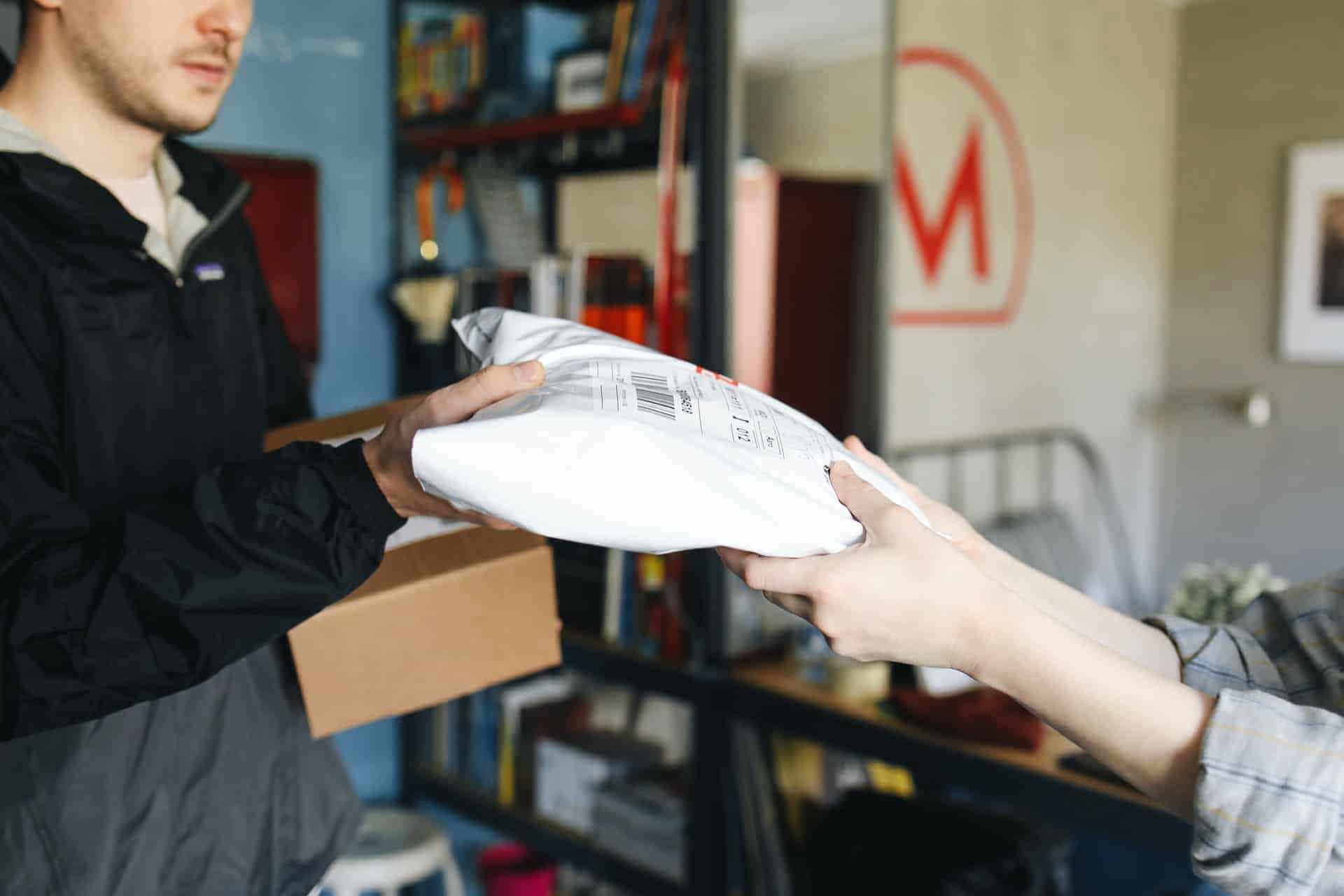
Creating efficient warehousing processes can result in less downtime, lower running costs, and better customer service. And what better place to start than right at the beginning: receipt of inward goods.
Here, we’ll talk about what receiving efficiency is, how to measure it using warehousing metrics, and cover a few different ways to optimise your inward goods process.
What is receiving efficiency?
Receiving efficiency is a useful warehousing metric that helps business owners determine whether their receiving process needs improvement. It can also be an important productivity key performance indicator (KPI), used to track progress and highlight areas where more training or better equipment may be required.
Although receiving efficiency is itself a KPI, other metrics can also assist in measuring how optimally your business receives goods. These include receiving cycle time, receiving accuracy, and more covered below.
 Tracking receiving efficiency across multiple locations can aid in identifying slow-moving processes.
Tracking receiving efficiency across multiple locations can aid in identifying slow-moving processes.
Why is receiving efficiency important?
Receiving efficiency is important because it contributes to the overall time and cost of order fulfilment.
By improving how quickly and accurately your business receipts goods, you’ll be able to reallocate those saved hours and dollars to the areas of the company that need them most.
More accurate receiving also helps prevent overstocking and understocking by providing clearer data for your inventory replenishment team to rely on.
Here are five reasons why you should improve your receiving efficiency:
- Reduce costs associated with receiving: Improving receiving efficiency can cut warehouse costs by reducing the time staff must spend on this necessary task. These benefits then have roll-on effects on the rest of the pipeline, since receiving comes first.
- Free up labour for other tasks: Reducing time spent on receiving inward goods can free up labour to help with other areas of importance, such as order picking. Staff members can go on to help further into the production pipeline, or use their extra time to optimise the warehouse itself.
- Improve inventory accuracy: Improved receiving efficiency typically leads to improved inventory accuracy in the warehouse. By getting better at receiving, checking, labelling, and putting away goods, you reduce the risk of inaccurate stock levels.
- Fewer trucks idling: Improved efficiency when receiving goods means less time trucks spend idling, waiting for their goods to be offloaded. If you own the trucks, it means they can go off to do other things. If your vendors own them, you’ll help make their people happy and improve your relationship with that partner.
- Spot red flags as they begin: Tracking receiving efficiency over time allows you to establish what your performance benchmarks are, and spot red flags as they arise.
So, how do you measure receiving efficiency in your warehouse?
Receiving efficiency KPIs & formulas
The performance of your receiving processes can be measured using the following receiving efficiency KPIs:
- Receiving efficiency – tracks efficient use of labour
- Receiving cycle time – tracks the time taken to receive goods
- Receiving accuracy – tracks how accurately goods are received
- Cost of receiving per line – tracks how much it costs you to receive goods
Let's break these KPIs down and look at the various receiving efficiency formulas that can help improve your productivity.
Receiving efficiency
This metric should be used to track the effectiveness of receiving process improvements and the impact of external events on the receiving process.
To measure receiving efficiency, pick a timeframe (i.e., one week) and then establish the volume of goods which passed through during that timeframe and the number of labour hours utilised by the warehouse at that time.
The formula for receiving efficiency is:
Volume of Received Goods / Number of Labour Hours = Receiving Efficiency
The higher the number, the more ‘efficiently’ your business is currently receiving goods.
In other words, a high number means you were able to receive a high number of goods within the labour hours available. A lower number or a number which is slipping could indicate a slow-down (and therefore a problem) with your process.

Receiving cycle time
This metric should be used to track how long it takes to complete the inward goods process.
Receiving efficiency should generally always be compared to receiving cycle time. It measures your dock-to-stock time – how quickly your team is able to put away the goods it receives, including preparation and processing.
The formula for receiving cycle time is:
Total Time to Put Away Received Goods / Total Number of Received Goods = Receiving Cycle Time
By comparing your receiving and put-away processes, you get a more holistic picture of the time and cost of all deliveries to your business.
Receiving accuracy
Receiving accuracy will tell you if there is something wrong with your receiving process.
Many inaccuracies may point at people rushing through their tasks to get them done quicker, or a need to implement a more accurate system such as barcoding.
To measure receiving accuracy, identify errors with inventory which relate to the put-away or receiving process. Compare those errors to the total amount of inventory that was put away within a set time frame.
The formula for receiving accuracy is:
Total Inventory Correctly Put Away / Total Inventory Put Away = Receiving Accuracy
Convert this number into a percentage. The closer it is to 100%, the fewer errors were found. Lower numbers indicate higher error rates, and therefore problems somewhere in the pipeline. These must be investigated.
Cost of receiving per line
The cost of receiving (per line) metric gives an idea of how much your receiving process is costing the business. This contributes to the total cost of goods sold – a critical metric for determining profitability.
Often people find that their best-selling products have such high costs-to-produce that they didn’t generate much profit and vice versa.
Do different product lines affect your bottom line? To figure that out, you’ll need to track the labour costs (and any other associated costs) of the receiving process for each product line, including put-away costs.
The formula for cost of receiving per line is:
Total Costs of Receiving / Total Number of Items Received in the Line = Cost of Receiving Per Line
You may find that some of your product lines create more inefficiencies than others. Use this information to adjust your processes, catalogue, and equipment as required.
Next up, how to improve receiving efficiency within a business. Let’s dive in.
 The cost of receiving goods can impact the profitability of your products, making it a crucial receiving metric to track.
The cost of receiving goods can impact the profitability of your products, making it a crucial receiving metric to track.
10 tips for improving receiving efficiency in your facilities
Receiving efficiency can be improved in numerous ways. This requires upfront planning and the breaking down of processes into their various steps then optimising each applicable step.
Without further ado, here are our top 10 tips for boosting your receiving efficiency.
1. Do it on paper first
Break down your receiving processes on paper before making any big changes. As the adage goes, you can’t break the rules until you know them first.
First, you must learn every single step of the process – not what you hope happens, but what really does happen.
Talk with the right people, get their perspectives, and observe or participate in some of the practices. Once you know the exact process being used, jot it all out on paper: what happens, when it happens, who’s involved, where things go and why.
When you’ve got everything mapped out, it will be much easier to identify inefficiencies.
2. Dedicate a time of day for receiving goods
One of the common causes of delays in receiving inward goods is human congestion.
This is especially true if you only have a small warehouse, or a small dock: Your picker is constantly stuck waiting for the receiver to finish putting away received goods so that they can pick an SKU from the same location.
That extra downtime is costing your business money (and can lead to grumpy employees).
For this reason, many businesses choose to dedicate a specific, low-traffic time of day entirely to inward goods receipt. Usually, this is first thing in the morning, when there’s less going on.
3. Talk to your suppliers
You may be able to optimise your receiving efficiency by asking suppliers to change how they operate.
If your staff are finding that they struggle, not due to their own processes, but because incoming goods are hard to handle, this could be a low-hanging fruit to tackle before making other major changes.
This process is called pre-receiving.
If you can make these requests, consider asking your suppliers to:
- Ensure all documentation is on hand and correct upon arrival.
- Ensure all goods for your business are available to be unloaded immediately, not stashed at the back behind someone else’s delivery.
- Correctly affix all product labels and ensure the details on each label are correct (and legible).
- Palletise loose cargo.
Keep track of which suppliers are best and worse when it comes to your receiving efficiency. It could be a factor to consider when you’re renegotiating future contracts.
 Work with your suppliers to help improve receiving times, including shipping vendors and salespeople.
Work with your suppliers to help improve receiving times, including shipping vendors and salespeople.
4. Do one thing at a time
Humans are often at their most efficient when they do one thing at a time. The same goes for receiving and putting away goods.
Consider trialling a system where warehouse staff only do one thing at a time, all at once.
This could be offloading, inspecting, labelling, determining where each package should go, and then putting things away. A singular-focussed approach like this can prevent people from stepping on each other’s toes or putting things away prematurely.
5. Invest in new hardware
Investing in new tools and equipment could help your people quicken their pace, and improve their accuracy, by better connecting them and your inventory management system.
Examples of hardware to consider include:
- Barcode scanners, to ensure goods can be added to the system instantly and accurately.
- Mobile label printers, to minimise transportation time within the warehouse.
- Mobile receiving carts can act as mobile workstations that carry all the equipment required for fast receipt of inward goods.
When selecting new equipment to invest in, always weigh up the potential return before making a purchase.
6. Invest in new software
To get the most out of new hardware, and to improve efficiency overall, you’ll likely require a software upgrade as well.
This is where inventory management software comes into play.
Inventory management software is a central system designed to track, measure, and inform about each stage of the production pipeline, from the supply chain through to shipping and freight.
Inward goods is an early part of this process, and vital if you want to keep an accurate inventory list.
Digitising this part of the process will allow you to utilise new technology (like barcode scanners), and access real-time data to help make all the maths and KPI calculations easier.
7. Always inspect thoroughly
Thorough verification of received goods is essential to ensure errors don’t go unmissed down the production pipeline.
Thorough inspections might slow down your receiving cycle time but could greatly improve your accuracy. Ensure that goods have been received in the correct quantity, with the correct codes, and in the correct condition.
Barcode scanners can make the process of stock counting infinitely quicker, although you’ll still need to check for damage by sight.
Just as importantly, you must track everything.
Should there be an error, note it in the system as soon as possible. Don’t rely on memory alone – put it in writing, in numbers. Then, over time, you’ll be able to paint a picture of who your most and least accurate suppliers are, which may affect your future relationships.
 When receiving goods, it's important to focus on maximising accuracy every step of the way.
When receiving goods, it's important to focus on maximising accuracy every step of the way.
8. Consider cross-docking
Cross-docking is a great cost-saver for certain business types. It’s where inward goods are received, sorted by final destination, and immediately moved onto outbound delivery vehicles for shipping.
Because these products barely touch the floor, so to speak, it greatly saves on inventory space and, therefore, carrying costs.
This process typically requires its own cross-docking facility, where inward delivery vehicles can arrive on one side and outward delivery vehicles park up on the other.
Goods are then simply transferred across the floor. Manufacturers may also use the same cross-docking concept to transfer finished products directly onto outbound vehicles without the need to store them.
It’s a very complex way of working, requiring a lot of careful planning. Additionally, it tends to only work best for companies with fast-moving products and a very mature logistics process.
Something to consider, but not to jump on without due diligence.
9. Optimise dock and warehouse layouts
Another way to use your space is to better optimise what you’ve got. When you go through your on-paper assessment, keep a half eye on not just what people are doing, but where they’re going.
Reducing the distance staff must travel to perform their duties can, over time, amount to quite a lot of time saved – not to mention the fact that it can reduce fatigue. Consider bringing certain areas of the warehouse closer together or reducing unnecessary backtracking.
On top of that, you may find there are efficiencies to be gained by adjusting where and how you store certain items.
For example, fast-moving items could go near the front, not the back. Goods which are commonly sold together could sit together. Items which are bulky and complex to move shouldn’t be stored around tricky corners or within narrow aisles.
10. Go lean
Finally, you may find you can improve your receiving efficiency by simply receiving fewer goods.
Many businesses around the globe are trying out lean just-in-time (JIT) business models as a way of cutting inventory-carrying costs. The less you store, the less it costs to store those items. Of course, the added benefit is that the less you store, the less you need to receive and put away.
You may even find that if you’re receiving fewer, faster-moving items, you can adopt some of the ideas behind a cross-dock and move inwards goods straight to where they need to go (whether that’s an outward-bound vehicle or simply a place where they can be put to use during production).
But, like cross-docking, this too is a more complex concept which isn’t for everyone. Learn more about going lean in our guide, Lean Manufacturing: What is it, How is it Done & Why?
